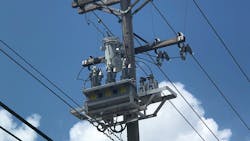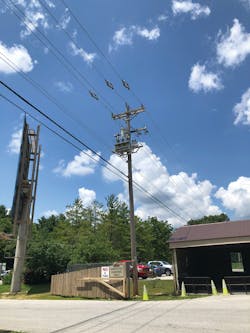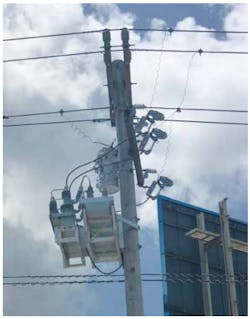White River Cooperative Adds Smart Capacitor Switch After Ride Outage
Anyone who has ever taken a small child to an amusement park knows not everyone can ride the roller coasters, but most want to as roller coasters are a star attraction for theme park operators. They also are one of the larger motor loads that keep the fun going throughout the venue. The last thing park operators or utility managers serving those sites want to see is an unplanned outage that leaves visitors stuck at the top of that steep slope leading to a roller coaster’s first dramatic plunge.
That can happen if an unplanned outage stops the motors that haul the cars up the incline, which is why engineers at White River Valley Electric Cooperative in Branson, Missouri, U.S., jumped into action after one of the utility’s biggest customers — Silver Dollar City — lost power to its largest roller coaster. To avoid this mishap in the future, the White River team added a smart capacitor switch with zero-closing function to a capacitor bank supporting the park. This one simple fix has kept roller coasters rolling and laughter flowing for one of the utility’s biggest customers.
Old-Time Fun
An 1880s-style theme park in Branson, Silver Dollar City is home to more than 40 rides and attractions, 100 resident craftsmen who help bring the past to life through skills like making candles and soap, plus award-winning food and entertainment. Hosting some 2.2 million guests annually, Silver Dollar City was named 2020’s No. 1 theme park in America by USA Today. It is one of many reasons for the city of Branson to be proud, and White River has plenty of protective measures in place to ensure power reliability to this important customer.
Served by two feeders out of a nearby substation, the park consumes a huge share of the substation’s ample capacity. Inside the park is a distribution automation system served by seven switchgears with vacuum fault interrupter (VFI) capability — four of which are on one feeder and three on the other — plus intelligence to automate switching and fault isolation within the park. If the utility loses one of the feeders going into the park, every load on the site can still be served by the other feeder.
Being an amusement park with numerous rides — many of which have sizeable inductive motors — Silver Dollar City has large loads with varying demand. The motor loads put reactive current onto the system, which is why the utility has a 300-kVAR pad-mounted capacitor bank inside the park and a larger 1200-kVAR capacitor bank not far beyond the park’s fencing. Both capacitor banks are on the same feeder. The pad-mounted bank inside the park was a fixed bank for many years and remained connected to the distribution system continuously.
This scheme worked until 2013, when Silver Dollar City debuted a new ride called Outlaw Run. At the time, it was the world’s steepest wood coaster. Its first drop features an 81-degree fall of 162 ft (49 m) — more than 16 stories — also making it one of the world’s fastest wood coasters, a gut churner that tops out at 68 mph (109 kmph). Voted best new ride of 2013 worldwide by Amusement Today, this ride is advertised as one that will test just about anyone’s grit.
As it turns out, it also tested the park’s power system. This is because inrush current, an initial surge of power when a motor like the one that drives Outlaw Run starts up, can be significantly higher than normal operating or steady-state current. It also can drive the need for reactive power on the system, which engages capacitor banks.
Mystery Outage
Soon after Outlaw Run was installed and undergoing routine testing, engineers at White River received a call letting them know the ride had no power. Troubleshooters discovered the VFIs had tripped on the switchgear feeding both the ride and capacitor bank near it.
They suspected trouble with the capacitor itself: a bad capacitor, animal intrusion or some other simple cause that could be addressed easily. However, when they opened the capacitor bank enclosure, they found absolutely nothing but some residue from the arcing that took out the fuse.
Initially, the utility crew isolated the capacitor bank and got the ride back on-line. Then, they got to work researching possible reasons for the problem, testing components within the bank itself and finding nothing wrong. After a few weeks, the team was still stumped when another blown fuse occurred at the padmounted capacitor bank. Again, they looked for problems within the bank itself. None appeared.
When capacitors are switched off, they are discharged and use zero voltage. As soon as they are switched on, they immediately charge from zero voltage to whatever the line voltage happens to be. If the capacitor bank is on a 13,200-V line, the moment it is switched on, the bank charges from 0 V all the way to 13,200 V. Because almost all capacitor bank switches are triggered to close at the same time, irrespective of the voltage difference on each phase of the bank, there often are large differences in voltage and polarity on one or more of the phases.
Once the switches close, the individual capacitor voltages settle in to follow along with the line voltage, but the initial voltage difference causes large transients, which are spikes in current lasting for a few cycles. The larger the capacitors switched in, the more transient current experienced in the vicinity of the bank and within it.
Engineers theorized the new ride added more demand for reactive power, which caused reactive switching between the two capacitor banks in and outside the park walls. Fortunately, right around this time, they found an IEEE article about issues related to back-to-back switching between two capacitor banks in close proximity to each other, as was the case with these two banks serving Silver Dollar City. When the team ran through the calculations found in the IEEE paper, they realized the amount of charging current at the capacitor banks was essentially equal to a transient fault current. Current rushing in to charge the capacitor can reach 2000 A or more. Although it only lasts a sub-second, over time, such short-duration high frequency conduction periods can eventually blow a fuse.
The problem was not with the capacitor bank equipment. It was with the proximity of the two banks. When one bank is too close to another bank, there is not enough line impedance between the two banks to dampen the transient effect or lower the inrush current. This issue was causing the fuses to trip.
The utility switched on the capacitor bank outside the park to provide reactive current because it needed the VAR support. However, because of the charging-current issue, engineers did not want to leave the other bank inside the park on while the outer bank was in a fixed position, so they shut it off. It was a quick fix to a complex problem that is more prevalent than many engineers realize. White River engineers knew they must find a way to get capacitance back onto the line. They started looking for a switch that would avert the heavy inrush of charging current.
The Solution
After looking at various options, White River engineers selected the Trinetics SmartClose three-phase, synchronous, zero-voltage close capacitor switch. Although other zero-closing solutions are available, alternatives consist of capacitor switches on top of the pole, a separate zero-close module and the main capacitor controller in the bottom of the pole. The solution chosen by White River does not require a secondary controller at the bottom of the pole to receive signals from the main controller.
Excluding the secondary controller simplified installation and made multiple calibration exercises between the secondary controller and switch unnecessary. It also eliminated repetitive maintenance in the field every few years from natural wear and tear in the capacitor switch that causes the calibrated parameters to drift, requiring the switch to be recalibrated to continue performing correctly.
The synchronous, zero-voltage close capacitor switches used by White River are different because they have built-in sensors and intelligence, which enables them to measure voltage precisely and close at the zero point on the waveform for each phase of the system. With built-in intelligence and six integrated voltage sensors, each switch senses when the 60-Hz sine wave passes zero voltage and closes in that instant. No voltage, no transients. Problem solved.
The synchronous, zero-voltage close capacitor used at White River has six integrated voltage sensors (two per phase — line and capacitor). The associated algorithm individually calibrates each phase for optimized performance to close within +/- 5 degrees of zero voltage.
Other zero-voltage capacitor switches simply time the close on each phase to reflect the 120-degree difference between the phases. In these switches, the voltage waveform of one of the three phases is measured using a voltage sensor or potential transformer. Then an algorithm applies a 120-degree offset for the other two phases. Each phase is not individually calibrated with its own respective voltage sensors.
The problem with this approach is the timing in which a switch closes, as it is limited by mechanical characteristics. Some capacitor switches may close in half a second, some may close in 10 cycles and some could take 40 cycles or more. Even if one of the capacitor switches happens to close when the capacitor voltage is zero, the other phase switches will close with a large voltage across them because there is no means to control the precise timing of the switches.
The capacitor switches used by White River also can close within 5 degrees of zero voltage, as opposed to the industry standard of 21 degrees. The standard 21 degrees reduces the impact of voltage transients during a capacitor close operation. Beyond 21-degree separation, the transients are significantly higher.
However, while the 21-degree standard minimizes transients, getting within 5 degrees of the zero-voltage point on the waveform eliminates transients. The integrated sensing and control in the SmartClose switch, which allows a close to within +/- 5 degrees of zero voltage, deliver four times the performance compared to the industry’s minimum requirement. Plus, the switch’s integrated validation software enables operators to verify the switches are opening and closing on the zero cross of the voltage waveform.
In addition, the three-phase, synchronous, zero-voltage close switches used by White River eliminate field calibration and commissioning, and they reduce the overall cost of installation. In part, that is because the capacitor switches are pre-calibrated — another benefit of keeping intelligence in the switch. The White River team put the rack together in the warehouse, then spent less than two hours installing it in the field.
The switches used by White River are solid dielectric switches with vacuum bottle technology to stop arcing. Other types of switches — oil interruption as well as insulated and vacuum interruption with oil insulation — use oil insulation that requires maintenance after every 3 years to 5 years. With solid dielectric switches, there is no oil in the switch, eliminating the need for maintenance for life.
Finally, the switches used by White River have a C2 restrike-free rating, primarily because of a solenoid mechanism that operates in less than 100 msec. This is important because, when a capacitor switch opens and disconnects a capacitor from the system, there is the possibility of a restrike. This is arcing across the interruption medium (oil or vacuum) as a result of the voltage difference between the line and the capacitor after it is disconnected from the line. Restrikes cause overvoltage on the system that can damage the switch. Depending on the number of restrikes that can occur with various capacitor switches, they typically are rated as C0, C1 or C2. If a switch is rated C1, it means it has a 1-in-50 chance of a restrike possibility; if it is rated C2, it means it has a 1-in-500 chance of a restrike.
One of the main reasons White River chose the SmartClose switch was because the engineers saw it working well for a nearby utility in Joplin, Missouri, where several capacitor banks were close together in an industrial park. The transients from switching were causing issues on variable frequency drives inside some of the manufacturing firms in this industrial park. While other solutions could address zero-voltage closing, installation of maintenance-free zero-crossing switches that do not require calibration during installation and operation and that work with any capacitor controller on the market solved the problem more efficiently and economically.
Improved Power Quality
Because elimination of large voltage transients was a key reason White River changed its capacitor switch technology, better power quality for all customers in the area was one of the main benefits the solution provided.
The park itself has a huge VAR demand. Any time a capacitor bank is off-line on a 95°F (35°C) day, power factor lags at the substation. While the utility has plenty of capacitance on the lines and is not overloading its system, it does cost the coop’s power supplier more to serve the load, which means more cost to coop members. Poor power quality also adds current on the lines, leading to more line losses. This means more cost to the customer, Silver Dollar City, because the park’s metering is on the primary feeder, upline from the padmounted capacitor bank within the park.
In addition to improving power quality, the zero-crossing SmartClose capacitor switch is a complete plug-and-play solution that requires zero additional training and zero field commissioning. Utilities can use any capacitor bank controller with the switch, even a simple time-of-day or temperature-based controller.
Synchronous, zero-close capacitor switches can help utilities to add capacitance in sensitive areas where it is crucial to minimize the power quality issues that capacitor-switching operations create as well as the line losses that go along with them. By using capacitors and switching them in an intelligent manner, utilities can reduce those losses tremendously.
Beau Jackson is manager of engineering and development at White River Valley Electric Cooperative.
Michael Kelley is vice president and general manager, utility automation group, Aclara.
For more information:
Aclara | www.aclara.com
About the Author
Beau Jackson
Beau Jackson is manager of engineering and development at White River Valley Electric Cooperative.
Michael Kelly
Michael Kelley is vice president and general manager of Aclara, a division of Hubbell Utility Solutions.




